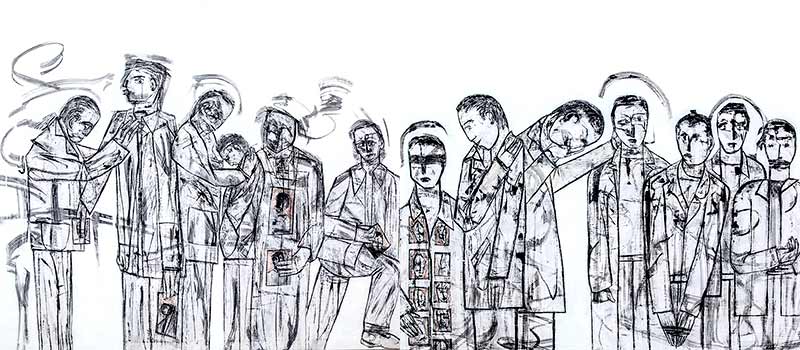
Title: ‘Ricky Romain’
Date: 17 June- 15 July
Artist Talk: Thursday 29th June 7pm (admission free)
IN THE ABSENCE OF TRUTH…..
‘I refuse to accept the view that humankind is so tragically bound to the starless midnight of racism and war that the bright daybreak of peace and brotherhood can never become a reality… I believe that unarmed truth and unconditional love will have the final word.’ Martin Luther King, Jr.
In this age of ‘alternative facts’ and ‘post truth’ politics it may appear that at the moment we are groping about in the ‘starless midnight of racism and war’. So, if we find ourselves unwillingly within this unknown and dangerous darkness, there is perhaps an obligation for all of us to search for points of light that have the potential to become stars.
An artist’s relationship with the truth is complex and intriguingly nuanced. Sometimes it is mystifyingly precarious; often it is more concerned with a poetic truth that depends on mutual understanding and empathy, it often necessitates leaps of imagination.
Honesty of purpose can sometimes have a subjective element that makes its integrity disputable. As Picasso asserted ‘Art is a lie that makes us realise the truth’. Often any element of ‘truth’ embedded in a work of art is something that reveals itself during the process of creation, not something that the artist intended to convey at its inception.
Ever since human creation the notion of ‘truth’ has been upheld by generations of people who agree that by respecting and celebrating its importance, society gains a collective strength – a foundation for justice to take place, a tool to protect the innocent and a universal absolute that validates ‘goodness’ and weakens ‘badness’.
Paradoxically, some media outlets that seemingly exist to uphold the truth, also create opportunities for anyone wishing to be ‘economical’ with it, to sabotage it, to deviously alter it, or replace the word ‘lie’ with euphemisms, that are darkly humorous.
Concealment of the truth is a growth industry and it is packaged seductively. Respect for ‘the truth’ is possibly more in jeopardy now than it has ever been, – its extinction could be a real possibility.
Engaging with contemporary human rights issues makes ‘the truth’ an even more potent element in any work of art, especially at a time in history when honour and probity do not seem to be prerequisites for high office. If the ‘bright daybreak of peace and brotherhood (and sisterhood)’ is to be experienced, its achievement depends on a refusal to accept that we are ‘tragically bound’ to an era of unethical and unprincipled governance.
The establishment of universal ‘unarmed truth and unconditional love’ is idealistic, a notion envisaged by a man whose dreams for society were brutally curtailed by his callous, racially motivated murder, but bullets could not, and still cannot, destroy his words. Thousands upon thousands of people understand them and incubate them, so they exist as seeds of hope inside all of those who have taken in their meaning.
Works of art can be rallying points, they can absorb the thoughts and interpretations of all who give their time to understand and appreciate them, (or criticise them?). In this way they continue to grow in significance as audiences share their humanity with them. This collective deciphering can be silent and secret, or vocal and vociferous. Whichever way comment is manifested it is usually part of a collaborative search for honesty of intent, and sincerity of expression from both artist and audience.
Artist Statement
“There are so many humanitarian challenges that impact on this particular time in history that I feel I can no longer work in isolation from them.
For the last 16 years I have endeavored to create work that reflects the complexity of political conflict surrounding prominent Human Rights issues.
My work is usually figurative, whether it is exploring the poignancy of single male figures, or revealing the multi-layered ambiguity of masculine groups.
The male figure is prominent because it reflects, via unconscious subjectivity, my own sensitivity in relation to global concerns. This in no way impedes my dedication to sexual equality.
I have recently exhibited paintings at the London headquarters of Amnesty International, at Tooks Chambers – the chambers of Michael Mansfield QC, The European Council Building in Strasbourg and at the Matrix Chambers in London.
It is especially fulfilling when exhibitions are collaborations that highlight the work of particular organisations. In this way my work acts as a focus for scrutiny and debate.
I am interested in working with organisations and institutions that would like use my imagery to act as a focus for what they do.”